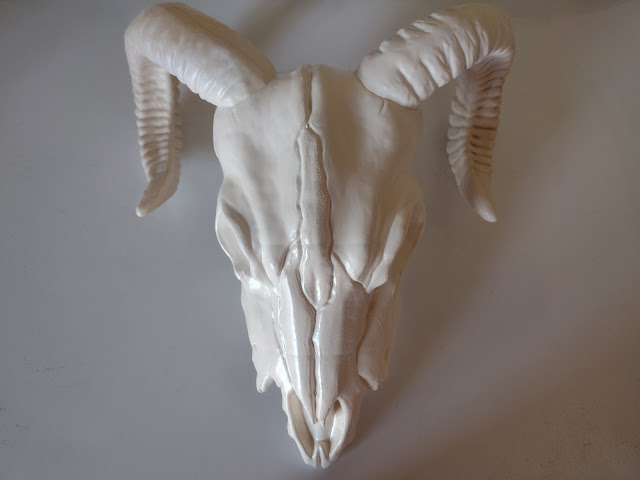$40 - $50 (based on 2025 prices)
Makes one skull
Makes one skull
I have wanted to do a cannibal island theme for years, but plans keep falling apart. In an effort to push the concept into reality, I made two tribal skulls to transition the haunt out of the creative ether and into the tangible real world. For this ram version, I went with a busy tribal design to contrast with the simplicity of the deer version. Although these are intended for a cannibal theme, you can easily cater them to fit other haunts, such as a voodoo or witch motif.
- One life-size plastic ram skull
- One 10 oz. can of interior/exterior, fast-drying spray paint in heirloom white*
- One 10 oz. can of interior/exterior, fast-drying spray paint in dark walnut*
- One 10 oz. can of interior/exterior, fast-drying spray paint in espresso*
- One 2 oz. bottle of acrylic paint in burnt umber*
- One 2 oz. bottle of acrylic paint in flat red*
- One 4 oz. bottle of all-purpose tacky glue*
- Four small plastic bones
- One bag of decorative wooden beads (roughly thirty beads per bag)
- Five to six yards of twine
2. Once the paint dries, wrap the skull in plastic and use painter’s tape to seal the space between the horns and skull. Then, working from dark to light, build up layers of dark walnut and espresso spray paint on the horns. It works best to apply a base coat of dark walnut followed by quick bursts of espresso. If the espresso becomes too heavy, you can also touch up portions with additional blasts of walnut.
3. After the paint on the horns dries, remove the skull from the plastic and brush its surface with a wash of burnt umber, ensuring the liquid settles into all the cracks and fissures. You might want to experiment with the consistency before doing this: the less water you add, the deeper/darker the wash; the more water you add, the fainter/lighter the wash.
4. Use red paint to detail the skull with tribal designs. What pattern you use is entirely up to you. You can create your own design or use one found in a reference book. Likewise, you can make the pattern symmetrical for a balanced appearance or irregular for more visual interest.
5. Repeat the procedures in steps one and three with the small plastic bones, giving each one a coat or two of heirloom white spray paint and a wash of burnt umber. Following this, cut two two-foot strands of twine and use them to bind the bones together. As you do so, utilize decorative wooden beads as spacers and leave a foot of excess to wrap around the horns in the next step.
6. Wrap the two one-foot sections of twine around the horns and allow the bones to dangle down between the eyes and nostrils. Although you can leave them loose, I glued them down to prevent them from catching in the wind and knocking against the skull.
7. Cut two six-foot sections of twine and wrap them around the remaining portions of each horn, threading beads onto random sections and gluing them down to serve as an anchor. How you decide to do this is entirely up to your chosen aesthetic for the prop: you can create balance with stripes that are evenly spaced or – as I did – something more chaotic.
8. Because the tribal pattern I used was rather busy, I tried to keep other details at a minimum to prevent the prop from being too overpowering; however, you can embellish the skull further with feathers, shells, or other accessories.
*You will not use the entire bottle’s content for this project.












































